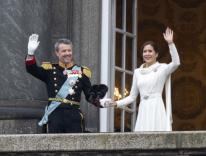My wife and I like to recite Compline (a.k.a Night Prayer) from the Liturgy of the Hours as the last thing we do before we turn out the lights. The one part of Compline that changes from season to season is the Marian Antiphon that is recited or chanted at the end. From the beginning of Advent until the Friday before the Feast of the Presentation of the Lord, the antiphon is the Alma Redemptoris Mater, a Latin hymn to Mary written in the 11th century by the monk Hermann Contractus.In the weeks leading up to Advent, I decided to teach myself (with some help from Jeff Tucker) to chant the antiphon in the original Latin. The process of learning forced me into a close encounter with the text and its deep--one might even say effusive--Marian piety:Alma Redemptoris Mater, quae pervia caeliPorta manes, et stella maris, succurre cadenti,Surgere qui curat, populo: tu quae genuisti,Natura mirante, tuum sanctum GenitoremVirgo prius ac posterius, Gabrielis ab oreSumens illud Ave, peccatorum miserere."Kindly Mother of the Redeemer, who art ever of heavenThe open gate, and the star of the sea, aid a fallen people,Which is trying to rise again; thou who didst give birth,While Nature marveled how, to thy Holy Creator,Virgin both before and after, from Gabriel's mouthAccepting the All hail, be merciful towards sinners."(Translation by Cardinal Newman via New Liturgical Movement)Throughout most of my life, this sort of thing has not been my spiritual cup of tea. I grew up at a time when visible expressions of Marian devotion seemed to vanish from the Church. Many prayers and devotions to Mary drip with the kind of pious sentimentalism that makes me want to run screaming from the room. For a variety of reasons, I've always been more comfortable with the bold, prophetic, and, yes, masculine Jesus than with the Mary who prays "let it be done to me according to thy word" (Lk 1:38). I take some comfort from the fact that Pope Benedict has faced his own challenges with Marian devotion.As I've grown older, though, I've come to have a greater appreciation of the contemplative virtues that Mary embodies. Sometimes my preference for vigorous action runs up against its limits. My wife suffers from a chronic illness that, while not life threatening, creates significant challenges for her. Medical treatments have had only limited success. In all likelihood, this is something that we will simply have to live with. The instinct of a husband is to protect his wife and it has been difficult for me to accept that this is a burden that I cannot lift from her shoulders. I will not deny that sometimes the prayer "let it be done to me according to thy word" is made through gritted teeth, but it is made none the less.Raymond Brown once observed that Mary often appears as a sign of hope for, as the Alma Redemptoris Mater puts it, fallen peoples who are struggling to rise again: Czestochowa, Lourdes, Knock, and, of course, Guadalupe. Mary's great prayer, the Magnificat, embodies the hopes of Israel for the coming of a King who will "scatter the proud in their conceit," "lift up the lowly," and fill the hungry with good things."I will confess, though, that all of this is more intellectus than affectus. I recently read a story in Jim Forest's book Praying With Icons that I felt captured my dilemma. Forest recounts the tale of a Dutch Protestant friend named Hannes who travels to Russia and visits an Orthodox church in Moscow. He encounters an icon of Mary holding the Christ child and stands before it in contemplation. An elderly Russian woman comes up to him and begins to talk to him. She asks him if he is a Christian. He assures her that he is and that there are many Christians in his country.
"And do they believe in the Father, Son and Holy Spirit?" She crossed herself as she said the words."Oh yes, Hannes assured her, but the doubt on her face increased; why had he not crossed himself?""Then she looked at the icon and asked, "And do you love the Mother of God?"Now Hannes was at a loss and stood for a moment in silence. Calvinist that he was, he could hardly say yes. At last he said, "I have great respect for her.""Such a pity," she replied in a pained voice," but I will pray for you." Immediately, she crossed herself, kissed the icon and stood before it in prayer.""Do you know," Hannes told me, "from that day I have loved the Mother of God."
Shortly after I read that story I purchased a small reproduction of the Our Lady of Vladimir icon, which now sits on my bureau next to a small icon of Christ. I contemplate the image of Mary in the morning and evening. My prayer to her is not for miraculous intercession or protection against the forces of evil. I simply ask that I may love the Mother of God.
Please email comments to [email protected] and join the conversation on our Facebook page.
Share
Previous Story
Human rights and foreign policy
Next Story
Avery Dulles, RIP

